 Using Targeted Red Light and Infrared for Pain Relief
Using Targeted Red Light and Infrared for Pain Relief
Nobody likes to live with pain — especially if we are talking about chronic pain. Chronic pain can be frustrating and sometimes debilitating. But what if I told you that you don’t have to accept living with pain forever? Using targeted red light and infrared light therapy for pain relief can not only momentarily reduce pain but tackle the root cause and improve your condition.
In this article, I will discuss the benefits of targeted red light and infrared light therapy for pain relief. You will learn about the problem with chronic pain. I will discuss what red and infrared light therapy are and their benefits. You will learn about how they may help to reduce inflammation and improve pain. Finally, I will share my favorite red light therapy device for pain relief, Kineon Move+ Pro.
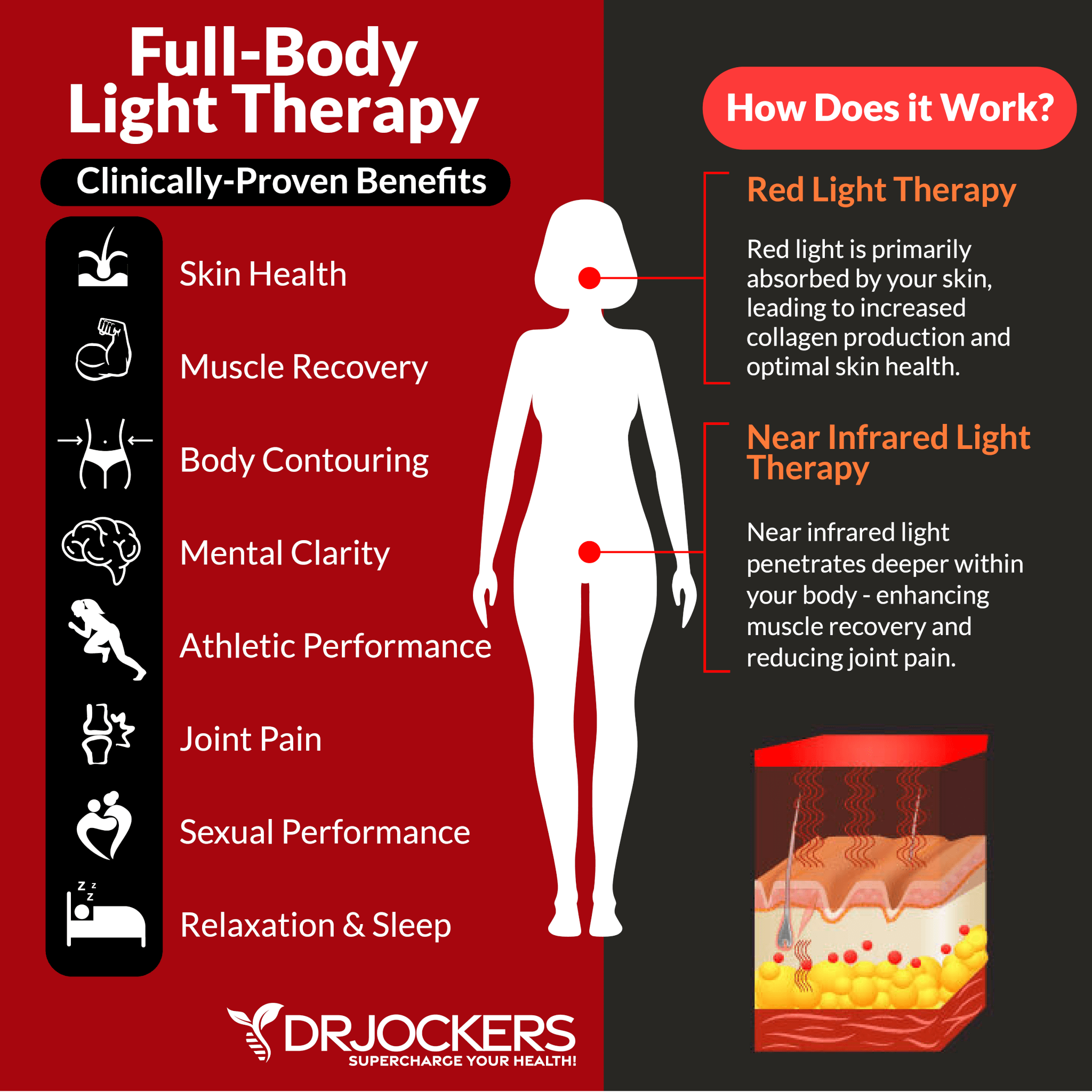
The Problem with Chronic Pain
Pain itself is not a bad thing. In fact, it’s an essential mechanism of your body to tell you something is wrong, you need to avoid danger, address a health issue, or let something heal. It’s an uncomfortable or unpleasant feeling that signals that something is off or needs care. It’s an essential protective mechanism. For example, pain will let you know not to talk around with a broken foot but rest and let it heal.
Pain becomes a problem when it turns chronic. There are two types of pain: acute and chronic. Acute pain comes on suddenly, and it is related to something specific, such as an accident, injury, surgery, cut, dental work, infection, illness, labor, childbirth, or something else.
Acute pain may last for a few hours, a few days, or maybe a few weeks. In serious cases, it may last for a month or two, but it will get better gradually as each day passes. This is the most important factor when it comes to acute pain: it comes on suddenly and then gradually gets better over time. Eventually, it goes away completely without anything else but a memory.
Chronic pain, on the other hand, doesn’t go away or comes back regularly. Chronic pain is pain that lasts for 6 months or longer. In some cases, chronic pain is present every day or every moment at some level. At other times, it goes away for a bit, then comes back in flares.
Sometimes chronic pain starts with a specific event and acute pain, such as an injury or illness. Instead of recovering, it never goes away completely. In other cases, chronic pain may develop without a specific event or a known reason. Sometimes chronic pain is a known symptom of a chronic health issue. In other cases, the cause is unknown. In all cases, your body’s pain signals stay active for months or years (1, 2, 3, 4).
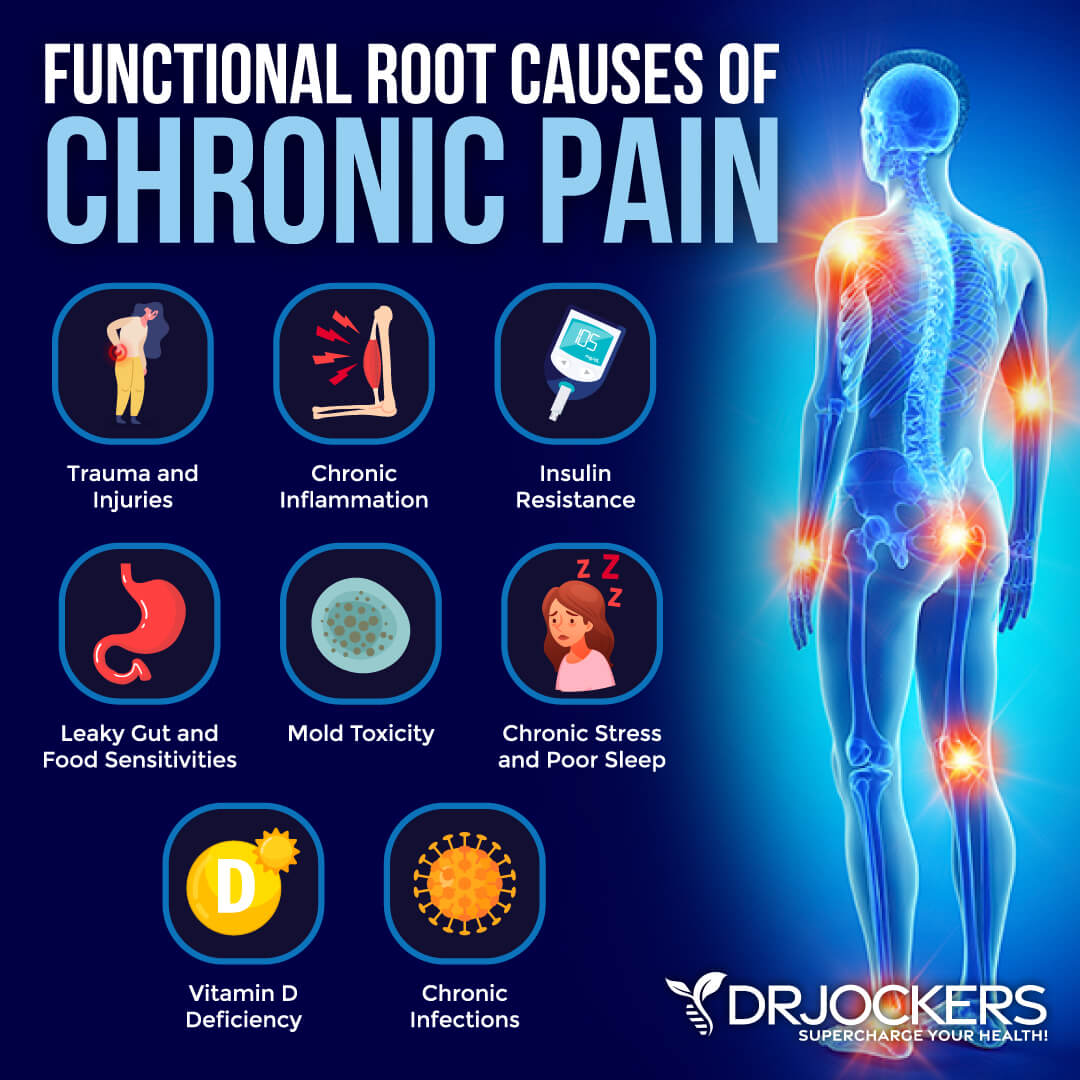
Signs and Symptoms of Chronic Pain
Symptoms of chronic pain can range from mild to severe. In some people, symptoms may change throughout the day, week, or month. Sometimes it’s mild or even non-existent, other times, it feels severe for a few hours, days, or weeks. In some cases, the pain level is somewhat stagnant without major flares or major pain-free periods. In some people or some periods, chronic pain may be debilitating. It may even lead to disability.
There are different forms and symptoms of chronic pain, which may include:
- Muscles tension and pain
- Joint pain and arthritis
- Back pain
- Nerve pain
- Fibromyalgia or widespread body pains
- Headaches and migraines
- Pelvic or bladder pain
- Cancer-related pain
Chronic pain may cause feelings of:
- Soreness
- Stiffness
- Throbbing pain
- Shooting pain
- Burning sensation
- Stinging sensation
- Dull ache
- Mixed types of pain
Depending on the type of chronic pain, you may experience:
- Tense muscles
- Low energy
- Changes in appetite or weight
- Limited ability to move your body
- Fatigue
- Poor sleep
Chronic pain may also seriously impact your emotional well-being and social well-being, causing:
- Anger
- Frustration
- Anxiety
- Depression
- Mood changes
- Fear of reinjury
- Fear of certain activities
- Inability to participate in or enjoy social events
- Isolation
- Loneliness
Overall, chronic pain can impact your physical health, emotional and mental health, social life, work life, education, and overall well-being. Finding and addressing the root cause of chronic pain is critical for your recovery. There are also some great tools that can address and reduce symptoms.
Targeted red light and infrared light therapy are great strategies for pain relief. They may also reduce chronic inflammation and other underlying issues behind your pain instead of just offering a band-aid approach for the pain. Let’s learn about targeted red light and infrared therapy for pain relief.
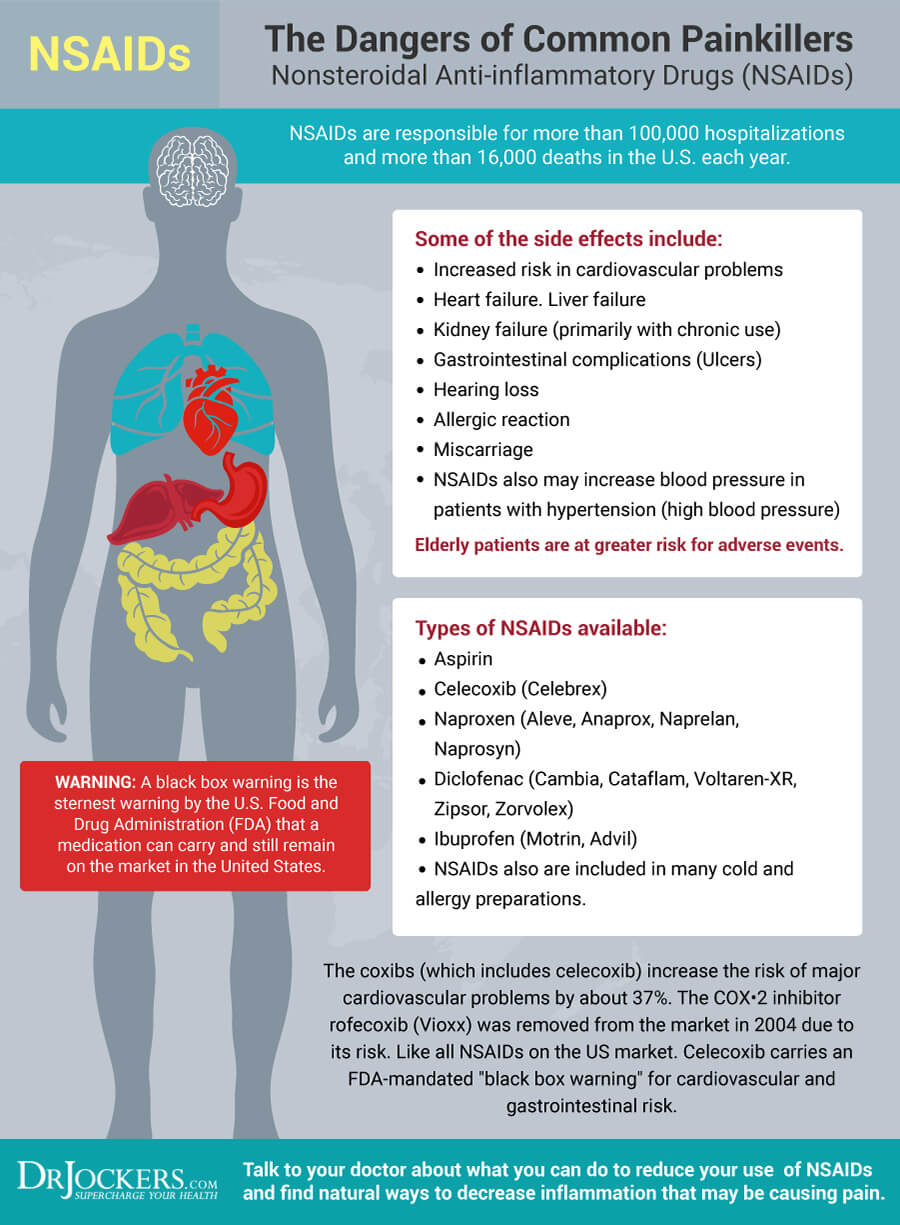
What is Red and Infrared Light
Red light therapy (RLT) and infrared light therapy are powerful therapeutic techniques used for inflammation, pain, skin rejuvenation, and other health benefits. Using red and infrared light has become a popular alternative and complementary healing tool you can use in your own home or at alternative medical practices, dermatology practices, and spas.
Red light therapy uses red low-level wavelengths of light, which are on the “long end” of the visible spectrum and have wavelengths of 630 nm to 700 nm. Red light therapy is the most effective when used at the surface of the skin. Infrared light therapy can penetrate deeper.
Infrared light is invisible with 800 nm to 1000 nm wavelengths. It can be used at the surface of the skin, but it can also penetrate deeply, about 1.5 inches into your body for deeper cellular support.
Unlike ultraviolet (UV) lights from the sun, red light therapy and infrared light therapy don’t burn your skin. There is no UV damage or sunburn. There is no suntan either. They offer a safe way to receive health benefits on a cellular level when standing or sitting several inches from a red light therapy device without risks.
Research, including a 2013 study published in the Seminars in Cutaneous Medicine and Surgery, has found that low-level laser red light therapy may help to decrease reducing pain and inflammation, support tissue repair and healing, and decrease scarring, acne, burns, and wrinkles (5, 6, 7). Infrared therapy may help to decrease inflammation and pain, facilitate detoxification, and stimulate autophagy to support your healing process on a cellular level (8, 9, 10).
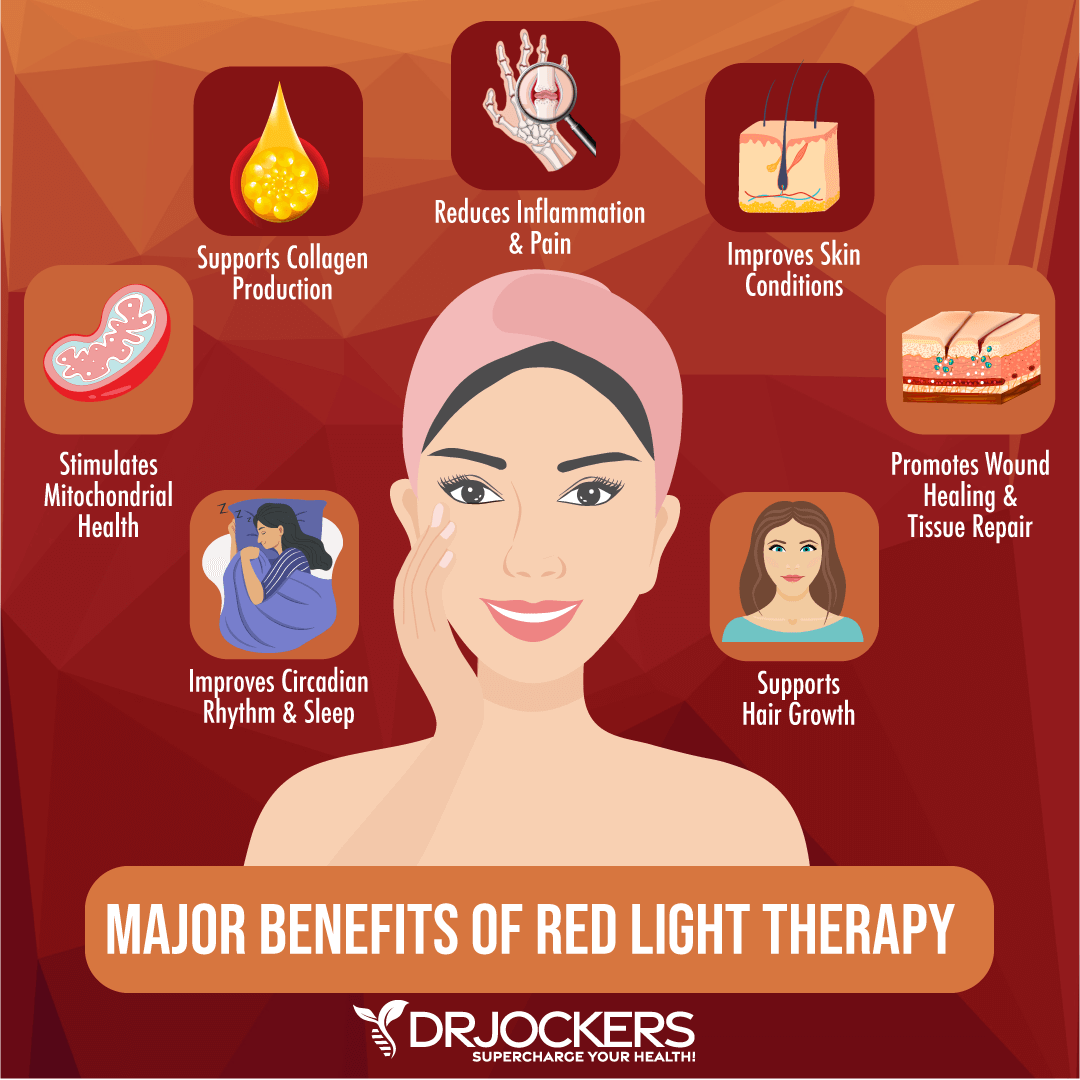
Benefits of Red and Infrared Light
The major benefits of red and infrared light therapy may include the following:
- Reduced inflammation: A 2017 study published in AIMS Biophysics has found that red light and infrared light therapy may have anti-inflammatory effects (11).
- Decreased pain: Red light and infrared light therapy may help to lower pain levels, especially joint-related and musculoskeletal pain. A 2000 meta-analysis published in the Journal of Rheumatology has found that red light therapy may help to improve osteoarthritis and rheumatoid arthritis symptoms (12).
- Improved microcirculation: A 2020 study published in Laser Surgery and Medicine has found that photomodulation may help to improve microcirculation and the creation of new blood vessels, supporting injury recovery (13).
- Activation of growth factors: According to a 2021 study published in Biomedicines, red and infrared light therapy may help to activate several growth factors, including nerve growth factor (NGF) and vascular endothelial growth factor (VEGF), supporting nerve and tissue repair (14).
- Improve joint and cartilage pain: A 2004 study published in In Vivo has found that photomodulation may help to improve cartilage and joint health (15).
- Improved mitochondrial health: A 2019 study published in the Annals of Translational Medicine has found that near-infrared light therapy may improve mitochondrial health and increase energy production (16).
- Better sleep quality: A 2016 review on brain disorders published in BBA Clinical has found that photobiomodulation may improve sleep (17).
- Improved endurance performance: A 2012 study published in the Journal of Athletic Training has found that red light therapy sessions may improve the endurance performance of female basketball players (18).
- Improved immune health: A 2012 study published in the Journal of Allergy and Clinical Immunology has found that light therapy may help to support vitamin D levels and immune health (19).
- Reduced symptoms of chronic health issues: A 2019 review published in Current Allergy and Asthma Reports has found that light therapy may help to improve inflammatory and autoimmune issues (20).
- Improved brain health: A 2016 review published in BBA Clinical has found that photobiomodulation may help to improve neurodevelopment and cognition (21).
- Better mental health: The same 2016 review has found that it may also improve anxiety, depression, post-traumatic stress disorder (PTSD), and other mental health issues (22).
- Increased hair growth: A 2019 meta-analysis, red light therapy may support hair density and hair growth and improve androgenetic alopecia (23).
- Better collagen production: A 2014 study published in Photomedicine and Laser Surgery has found that red light may improve collagen production, supporting both skin and joint health (24).
- Improved skin health: A 2014 review published in Anais Brasilienos de Dermatologica has found red light therapy may help wound healing and tissue repair, reduce skin inflammation, and improve collagen and fibroblast production for skin health (25).

How Red and Infrared Light Reduce Inflammation
Red and infrared light therapy may be great options for reducing chronic inflammation. According to a 2017 study published in AIMS Biophysics, photomodulation by red and infrared light therapy may help to fight oxidative stress, offer antioxidant benefits, and reduce inflammation (11). It may help to reduce the expression of pro-inflammatory factors, which helps to alleviate inflammation, chronic pain, and symptoms of chronic health conditions.
They may help to reduce muscle and joint-related inflammation and pain related to injuries, inflammatory conditions, and autoimmunity. According to a 2000 meta-analysis published in the Journal of Rheumatology, they may help to improve osteoarthritis and rheumatoid arthritis symptoms (12).
It may stimulate stem cell production, resulting in improved cartilage regeneration and faster recovery from injuries. Red and infrared light therapy may also be great for inflammatory conditions of the skin, such as psoriasis, as well as wound healing (21).

Using Targeted Red and Infrared Light for Pain Relief
Since inflammation often comes with pain and chronic pain is usually characterized by chronic inflammation, this is great news if you are dealing with chronic pain! Red and infrared light therapy are fantastic options for pain relief and reducing the frequency and severity of your pain levels.
Targeted red light and infrared can help to suppress pain signaling molecules, providing relief from chronic pain and reducing the need for medications. It may support better blood flow and improved circulation to treated areas by dilating blood vessels and promoting the growth of new blood vessels, leading to faster healing, reduced swelling, and improved overall health.
Targeted red light and infrared is a great option not only for people with chronic pain. If you are an athlete, work out regularly, or have a physically demanding job, red and infrared light therapy can reduce soreness, muscle pain, and joint issues. It may be a good option for reducing pain related to a sit-down job or poor posture. If you are recovering from an acute injury, targeted red and infrared right therapy may also be fantastic options for pain relief and supporting healing.

Introducing the Kineon Move + Pro
If you are looking to experience the benefits of targeted red light and infrared light therapy for pain relief, I recommend Kineon Move+ Pro. As you already know, red light therapy can relieve pain, improve blood flow, reduce inflammation, lower inflammation, and enhance cartilage healing.
Kineon Move+ Pro is designed to offer long-term relief from chronic pain. It’s a perfect option if you’ve tried countless treatments, medications, and even surgery, yet still struggling with pain. It is a perfect complimentary or stand-alone option for pain that helps to address underlying issues (inflammation!) and stop pain in its tracks! You can experience significant pain relief using this device for as little as 10 minutes a day.
With so many red-light devices out there, you may wonder how Kineon Move+ Pro is different from its counterparts. Many other red-light devices rely solely on LEDs. Kineon Move+ Pro uses dual-light technology that combines medical-grade laser technology with traditional LED lights. It offers targeted, dosage, and penetration depth with the help of laser light offers what devices using LED miss.
Targeted Red Light and Pulsed Wave Technology
This device also uses Pulsed Wave (PW) technology, distinguishing it from rival devices that employ Constant Wave (CW) technology. PW uses brief bursts of light with relatively high energy levels, whereas CW maintains a continuous stream of light at lower energy levels. This means that Kineon Move+ Pro can deliver higher energy levels, enhancing penetration depth without inflicting tissue damage.
Kineon Move+ Pro is a safe, non-invasive, enhanced light therapy device created to improve movement, relieve knee and joint pain, and relieve chronic pain. It may be your answer if you have joint pain, including rheumatoid arthritis, osteoarthritis, and gout. It’s also fantastic for sports injuries, inflammation-related pain, and other chronic pain.
It may help you to relieve pain without over-the-counter non-steroidal anti-inflammatory drugs (NSAIDs), corticosteroids or other anti-inflammatory medication. It works well in combination with physical therapy, strength training, anti-inflammatory nutrition, and lifestyle changes. You can use it on different body parts, try different settings, and experiment with different lengths of treatment. Only 10 minutes a day while working or doing other tasks can offer great benefits.
Kineon Move+ Pro offers:
- Targeted, precise pain relief through advanced laser technology
- A portable, handheld device that delivers powerful results.
- No ongoing costs or subscriptions – just a one-time purchase
- A risk-free 30-day money-back guarantee (either you notice a reduction in your pain, or you’ll get your money back!)
Take a step toward a pain-free life. Try Kineon Move+ Pro. Use the coupon code DRJOCKERSMOVE+ at checkout to save $50 on the MOVE+ Pro today and start living pain-free!
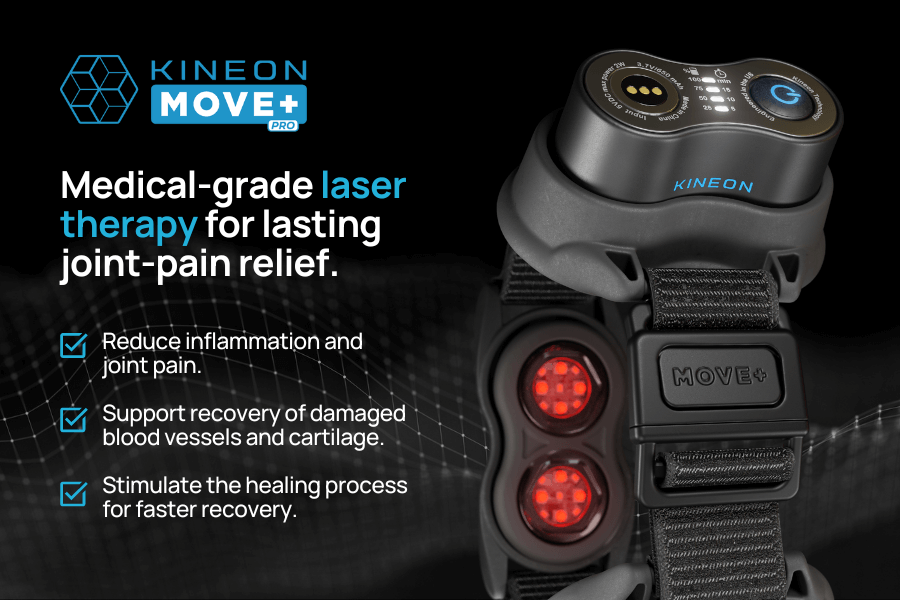
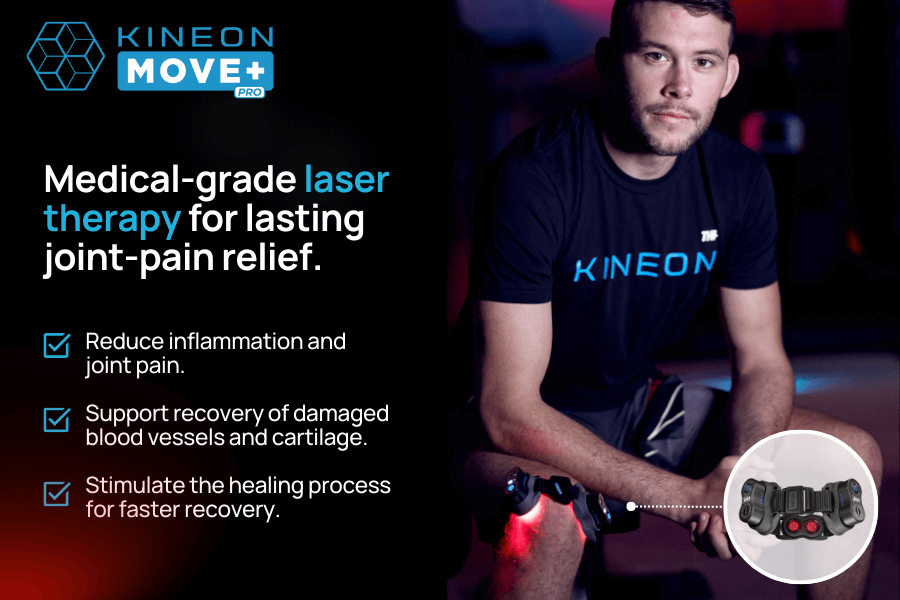
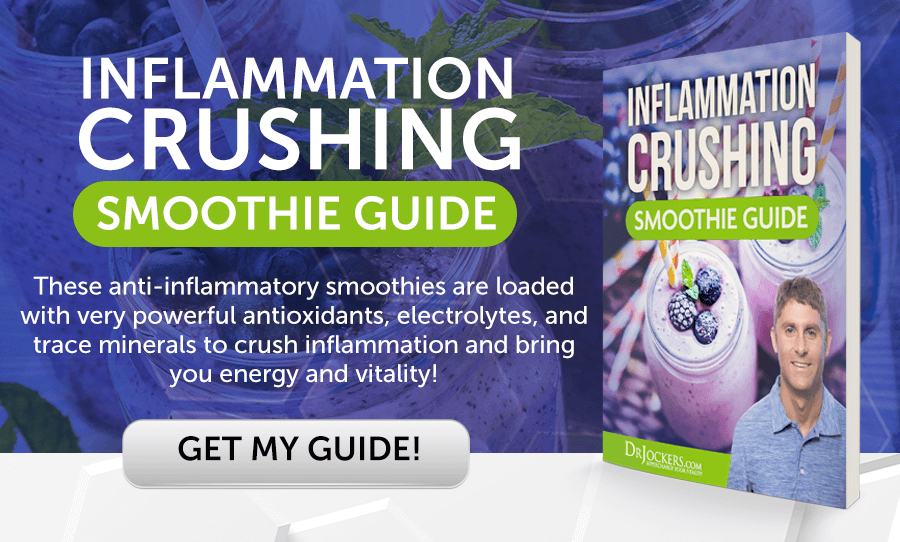


Can i buy the light therapy
I have severe neuropathy in my feet, mostly the toes. I need the light therapy for that pleases, and soon.
Dr. Jockers
Do you know if NIR also works for severe orsteoporosis, sever chronic venous insufficiency and big and lots of veins on arms and varicose veins on legs and blue veins all over the body